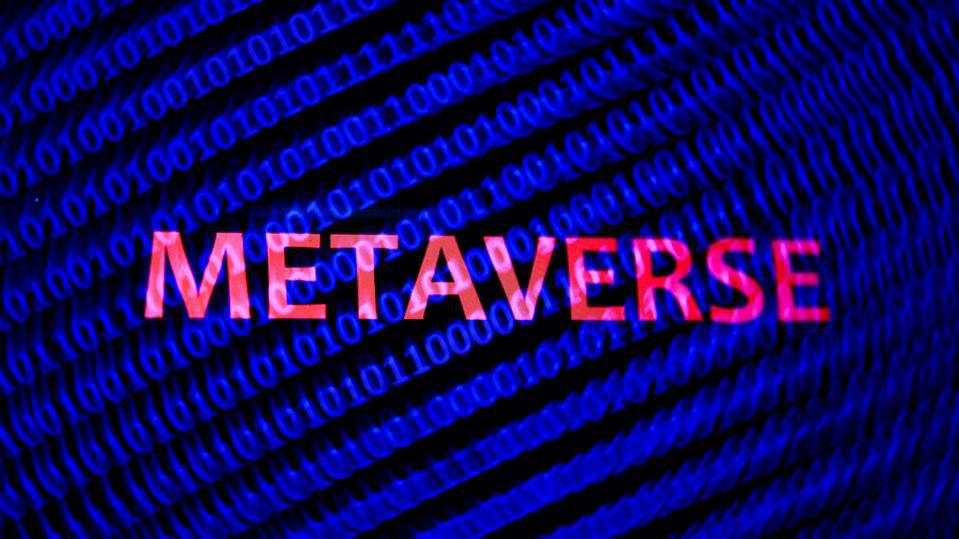
Editorial Note: We earn a commission from partner links on Forbes Advisor. Commissions do not affect our editors’ opinions or evaluations.
The metaverse is one of the internet’s favorite new buzzwords.
If you’re new to the party, the metaverse is the latest iteration of virtual reality, or worlds accessed by people using virtual reality headsets. From shopping and entertainment to learning and gaming, some tech firms see the metaverse as a new frontier that could be as transformative as the world wide web was a generation ago.
This broadly futuristic concept became a household word after Facebook rebranded itself as Meta Platforms last year.
Cryptocurrency is beginning to play a key role in certain precincts of this brave new world. However, its role in shaping the metaverse has been complicated by the big declines of the crypto winter throughout 2022.
Here’s a look at the top metaverse coins—cryptocurrencies that play a role in facilitating commerce and exchange within the metaverse—that have market capitalizations greater than $500 million.
1. Internet Computer (ICP)
Internet Computer was developed by the Swiss nonprofit organization Dfinity Foundation. The goal of ICP is ambitious: Replace the centralized internet that we are all familiar with today with a decentralized alternative.
The thinking is that today’s internet is primarily built by centralized companies like Alphabet—which owns the family of Google products—or Amazon.com.
Launched in May 2021, Internet Computer seeks to change that order, striving to give users the ability to move to a more inclusive, open-source internet. It aims to execute this vision with smart contracts, offering enhanced speeds with reduced computational costs.
Backed by big names like venture capitalist (VC) Andreesen Horowitz, its performance has been brief but turbulent. Initially, ICP gathered a towering market cap of more than $45 billion when the token traded for around $700.
While it’s still one of the larger cryptos around, enthusiasm has waned. ICP’s price is significantly down from its initial highs.
2. Stacks (STX)
Bitcoin (BTC) may be the granddaddy of all blockchains, but its role in the metaverse was somewhat unclear until Stacks launched on top of it.
Stacks is a layer-one blockchain that connects with Bitcoin’s blockchain through STX’s own proof-of-transfer (PoX) mechanism. With this technology, Bitcoin miners can pay to mint new STX tokens. In addition, Stacks holders can stack (as opposed to staking) their own STX coins to earn BTC rewards.
Stacks’ main goal is to bring Web3 decentralized applications (dApps) and smart contracts to the oldest and most secure blockchain in the world, Bitcoin. It was founded by a host of venture capital funds, including those of Winklevoss Capital, Y Combinator and Digital Currency Group.
The first cryptocurrency to receive approval for sale by the Securities and Exchange Commission (SEC), Stacks 2.0 launched its mainnet in January 2021.
3. Axie Infinity (AXS)
Axie Infinity took the crypto world by storm during the Covid-19 pandemic, emerging as the biggest “play-to-earn” game, blazing a trail for the likes of Sandbox and Decentraland.
Axie Infinity is inspired by popular games like Pokémon and Tamagotchi, and in many ways, it’s similar. Players pit cute-looking monsters against each other to win in-game tokens.
Unlike its centralized cousins, Axie Infinity is domiciled on the blockchain, monsters are bought in the form of NFTs and the tokens earned—AXS—is a cryptocurrency trading actively on the market.
AXS was wildly popular during the pandemic as a way for people to earn money while locked up at home. As the play-to-earn model grew, however, criticism was leveled at its hierarchical nature.
Richer investors, known as scholars, could purchase the expensive NFT monsters before leasing them out to players, known as workers, in lower-income countries. Axie Infinity is extremely popular in the Philipines, Venezuela, the U.S., Thailand, and Brazil, in that respective order.
Players receive only a cut of the proceeds earned for playing—lacking the financial means to purchase the NFTs without a go-between.
4. The Sandbox (SAND)
The Sandbox is a virtual world with native tokens to transact with in-game digital assets. SAND can be earned and spent within the Sandbox, just like MANA in Decentral…
#Top #Metaverse #Coins #Forbes #Advisor
- SEO Powered Content & PR Distribution. Get Amplified Today.
- PlatoData.Network Vertical Generative Ai. Empower Yourself. Access Here.
- PlatoAiStream. Web3 Intelligence. Knowledge Amplified. Access Here.
- PlatoESG. Carbon, CleanTech, Energy, Environment, Solar, Waste Management. Access Here.
- PlatoHealth. Biotech and Clinical Trials Intelligence. Access Here.
- Source: https://cryptoinfonet.com/metaverse-news/forbes-advisors-7-best-metaverse-coins/
- :has
- :is
- :not
- $UP
- 2021
- 2022
- 7
- a
- ability
- accessed
- actively
- addition
- advisor
- affect
- After
- against
- ago
- aims
- All
- alternative
- ambitious
- and
- Andreesen
- Andreesen Horowitz
- applications
- Applications (DApps)
- approval
- ARE
- around
- AS
- Assets
- At
- Axie
- Axie Infinity
- AXS
- BE
- became
- been
- before
- Beginning
- BEST
- best Metaverse
- Big
- Biggest
- Billion
- Bitcoin
- Bitcoin Miners
- BLAZING
- blockchain
- blockchains
- bought
- brave
- Brazil
- bring
- broadly
- BTC
- built
- but
- by
- CAN
- cap
- capital
- centralized
- certain
- change
- Coins
- COM
- Commerce
- commission
- commissions
- Companies
- complicated
- computational
- computer
- concept
- connects
- continue
- contracts
- Costs
- could
- countries
- COVID-19
- COVID-19 pandemic
- criticism
- crypto
- Crypto Winter
- cryptocurrency
- cryptocurrency trading
- CryptoInfonet
- cryptos
- Currency
- Cut
- DApps
- Decentraland
- decentralized
- Decentralized Applications
- Declines
- developed
- Dfinity
- Dfinity Foundation
- digital
- Digital Assets
- digital currency
- digital currency group
- do
- domiciled
- down
- during
- each
- earn
- earned
- emerging
- enhanced
- Entertainment
- enthusiasm
- evaluations
- exchange
- execute
- expensive
- extremely
- facilitating
- familiar
- family
- Favorite
- financial
- firms
- First
- For
- Forbes
- form
- Foundation
- Founded
- from
- Frontier
- funds
- futuristic
- game
- Games
- gaming
- gathered
- generation
- Give
- goal
- greater
- grew
- Group
- Have
- headsets
- hierarchical
- Highs
- holders
- Home
- Horowitz
- host
- household
- However
- HTTPS
- ICP
- in
- in-game
- Including
- Inclusive
- Infinity
- initial
- initially
- inspired
- Internet
- Internet Computer
- Investors
- IT
- iteration
- ITS
- itself
- January
- January 2021
- jpg
- just
- Key
- known
- larger
- Last
- Last Year
- latest
- launched
- learning
- leasing
- like
- likes
- LINK
- links
- locked
- Look
- Main
- mainnet
- MANA
- many
- Market
- Market Cap
- May..
- means
- mechanism
- Meta
- META PLATFORMS
- Metaverse
- metaverse coins
- million
- Miners
- mint
- model
- money
- more
- most
- move
- names
- native
- Nature
- Navigation
- New
- NFT
- NFTs
- Nonprofit
- note
- of
- offering
- oldest
- on
- ONE
- only
- open source
- Opinions
- opposed
- or
- order
- organization
- Other
- our
- out
- own
- owns
- pandemic
- partner
- party
- Pay
- People
- performance
- PIT
- Platforms
- plato
- Plato Data Intelligence
- PlatoData
- Play
- play to earn
- players
- Pokémon
- Popular
- price
- primarily
- proceeds
- purchase
- Reading
- Reality
- rebranded
- receive
- Reduced
- replace
- respective
- Rewards
- Role
- s
- sale
- SAND
- sandbox
- Scholars
- SEC
- secure
- Securities
- Securities and Exchange Commission
- see
- Seeks
- shaping
- Shopping
- significantly
- similar
- smart
- Smart Contracts
- some
- somewhat
- speeds
- spent
- stack
- Stacks
- Still
- Storm
- striving
- STX
- Swiss
- tech
- Technology
- Thailand
- than
- that
- The
- the metaverse
- The Sandbox
- the world
- Them
- Thinking
- this
- those
- Through
- throughout
- to
- today
- today’s
- token
- Tokens
- took
- top
- traded
- Trading
- trail
- transact
- transformative
- turbulent
- u.s.
- until
- users
- using
- Venezuela
- venture
- venture capital
- venture capitalist
- Virtual
- Virtual reality
- virtual world
- vision
- waned
- was
- Way..
- ways
- we
- web
- Web3
- when
- while
- wide
- win
- Winklevoss
- Winter
- with
- within
- without
- Word
- workers
- world
- world’s
- Y Combinator
- year
- zephyrnet













